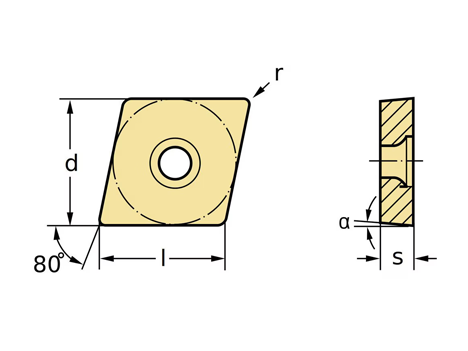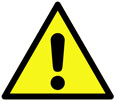80° Carbide Insert
While carbide inserts may have a higher upfront cost, they offer excellent value by providing four usable cutting edges per insert and significantly reducing time spent on tool sharpening.
Carbide cutters excel at machining difficult materials such as cold-rolled steel, stainless steel, and bronze, delivering consistent performance and long tool life. They are also compatible with aluminum, brass, and leaded steels—though for these softer materials, a finely honed high-speed steel tool may still yield the best surface finish.
This is the 10-pack of replacement carbide inserts for the following tool holders:
- 80° Carbide Tool Holders
- 80° RH 3/8″ Boring Bar
- 80° LH 3/8″ Boring Bar
- 80° RH 3/8″ Boring Bar w/2 Flats
- 80° LH 3/8″ Boring Bar w/2 Flats
In stock
-
| INSCRIBED CIRCLE | 0.250″ (6.35 MM) |
| CUTTING EDGE LENGTH | 0.254″ (6.45 MM) |
| INSERT THICKNESS | 0.094″ (2.38 MM) |
| CLEARANCE ANGLE MAJOR | 11° |
| INCLUDED ANGLE | 80° |
| ISO INSERT DESIGNATION | CPMT 21.51 |
| CORNER RADIUS | 0.016″ (0.4 MM) |
| MINIMUM FEED PER REVOLUTION | 0.002″ (0.05 MM) |
| MAXIMUM FEED PER REVOLUTION | 0.006″ (0.16 MM) |
| DEPTH OF CUT MINIMUM | 0.004″ (0.1 MM) |
| MAX DEPTH OF CUT | 0.059″ (1.5 MM) |
Related products
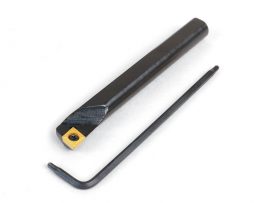

Carbide Insert RH 80° 3/8″ Boring Bar w/2 Flats
Sherline’s gang-tooling tool post (P/N 5930) was specifically designed for customers converting their Sherline lathe into a chucker-style or gang-tooling lathe. Since most parts produced on a chucker lathe are 1/2" (13 mm) in diameter or smaller, and the center-to-center spacing on our gang-tooling post is 1.5" (38 mm), we identified a practical opportunity: our boring bars can double as both boring and outside diameter (O.D.) turning tools.
To support this dual use, we modified our standard boring bars by adding a second locating flat. This allows them to be mounted with the insert face up or face down, providing flexibility for front- or back-side operations. For example, right-hand 80° and 55° boring bars can now be used effectively on either side of the part (see Figure 1).
These 3/8" diameter boring bars are designed to hold a 2-sided 80° carbide insert, secured with a Torx® screw. Each holder includes an 80° carbide insert and a Torx driver.
-
Each holder is 3-1/4" long and can bore to a depth of just over 2" when secured with two set screws.
-
Constructed from 1144 Stressproof® steel with a black oxide finish for strength and corrosion resistance.
See instructions below for additional guidance on using two-flat boring bars with gang tooling setups.
Pro Tip: Consider using the boring bar with the insert face down to help reduce chip buildup on the insert during cutting. This orientation can improve chip evacuation and extend insert life.
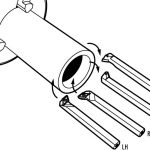
FIGURE 1—55° boring bars used as examples. The left-hand tools are used as turning tools, while the right-hand tools are used as boring tools.
Note: The straight-groove chip breaker shown in some older images is no longer available. Current inserts feature the spider web-style chip breaker as shown here
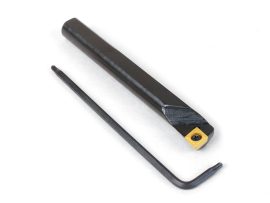

Carbide Insert LH 80° 3/8″ Boring Bar w/2 Flats
Sherline’s gang-tooling tool post (P/N 5930) was specifically designed for customers converting their Sherline lathe into a chucker-style or gang-tooling lathe. Since most parts produced on a chucker lathe are 1/2" (13 mm) in diameter or smaller, and the center-to-center spacing on our gang-tooling post is 1.5" (38 mm), we identified a practical opportunity: our boring bars can double as both boring and outside diameter (O.D.) turning tools.
To support this dual use, we modified our standard boring bars by adding a second locating flat. This allows them to be mounted with the insert face up or face down, providing flexibility for front- or back-side operations. For example, right-hand 80° and 55° boring bars can now be used effectively on either side of the part (see Figure 1).
These 3/8" diameter boring bars are designed to hold a 2-sided 80° carbide insert, secured with a Torx® screw. Each holder includes an 80° carbide insert and a Torx driver.
-
Each holder is 3-1/4" long and can bore to a depth of just over 2" when secured with two set screws.
-
Constructed from 1144 Stressproof® steel with a black oxide finish for strength and corrosion resistance.
See instructions below for additional guidance on using two-flat boring bars with gang tooling setups.
Pro Tip: Consider using the boring bar with the insert face down to help reduce chip buildup on the insert during cutting. This orientation can improve chip evacuation and extend insert life.

FIGURE 1—55° boring bars used as examples. The left-hand tools are used as turning tools, while the right-hand tools are used as boring tools.
Note: The straight-groove chip breaker shown in some older images is no longer available. Current inserts feature the spider web-style chip breaker as shown here
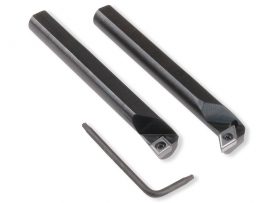

LH 55° & 80° 3/8″ Boring Bars w/Carbide Inserts
These 3/8" diameter boring bars hold a carbide insert secured with a Torx screw. Each comes with either a 2-sided 55° or 80° carbide insert and Torx wrench. The 55° LH boring tool will fit into a 3/4" starting hole. The 80° holder will fit into a smaller 1/2" hole. The 80° holder offers a little more strength for roughing cuts while the 55° insert will cut into sharper corners. The 3-1/4" long holder can bore a hole a little over 2" deep with two fastening screws tightened on it. The holders are made from 1144 Stress-proof steel with a black oxide finish. Available individually.
Left Hand Boring Bars
These LH boring bars are not intended to be used for boring on a standard Sherline lathe, as the spindle is not reversible without electronic modifications. They were developed for a Sherline tool that is now in development where they will be used as a turning tool from the backside with the bit upside down. Watch for the introduction of this new “chucker” lathe soon.
Advantages of Using Carbide Insert Tools
Though relatively expensive, if a cutting edge of a carbide insert becomes dull or chipped, the insert can be removed and rotated 180° to expose two new cutting surfaces, providing, in effect, two tools for the price of one.
The primary method of cutting metal on miniature machine tools is usually with high-speed steel tools as they are inexpensive, easily resharpened and can be ground into "form" tools for special jobs. However, inserted tip carbide tools can be lifesavers for some jobs. Though more expensive and not able to be resharpened, carbide tools hold their cutting edge when cutting exotic metals like stainless steel or titanium or abrasive materials like carbon fiber and can speed up the cutting process. This is why they are used for most cutting tasks in the modern professional machine shop.
NOTE: A tool is named by the direction from which the chip leaves the tool; so a right-hand tool has its cutting edge on the left and the chip peels off to the right.

80° Carbide Insert-10 Pack
While carbide inserts may have a higher upfront cost, they offer excellent value by providing four usable cutting edges per insert and significantly reducing time spent on tool sharpening.
Carbide cutters excel at machining difficult materials such as cold-rolled steel, stainless steel, and bronze, delivering consistent performance and long tool life. They are also compatible with aluminum, brass, and leaded steels—though for these softer materials, a finely honed high-speed steel tool may still yield the best surface finish.
This is the 10-pack of replacement carbide inserts for the following tool holders:
